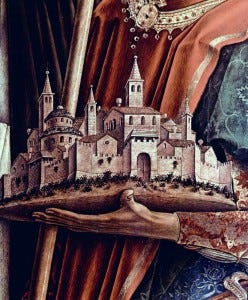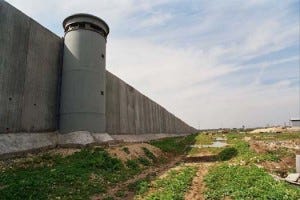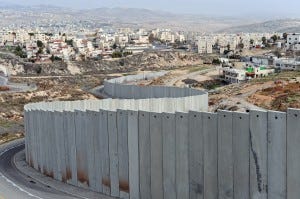
I was glad when they said to me, "Let us go to the house of the LORD."
Now our feet are standing within your gates, O Jerusalem.
Jerusalem is built as a city that is at unity with itself --
Pray for the peace of Jerusalem …
Peace be within your walls and quietness within your towers.
from Psalm 122
The story is told of an old man who’d been visiting the Western Wall (otherwise known as the Wailing Wall) in Jerusalem for many years. Turning his face to this last remaining ruin of the ancient Jewish temple in the Old City, he would nod his head repeatedly, while reciting the same silent prayer over and over again. One day a reporter approached the man and asked how he felt, given the current state of affairs. “How does it feel?” the old man replied. “It feels like I’ve been knocking my head against a brick wall.” We know all too well the ongoing dispute between Israelis and Palestinians in the divided city of Jerusalem; where a 26’ high security barrier made of solid concrete partitions the city, as part of a 430-mile long physical barrier being constructed along the West Bank. But it is not simply a global hotspot of international tension and conflict. In the context of a shared biblical tradition and the three Abrahamic faiths (Judaism, Christianity and Islam) both the old Western Wall and the new concrete barrier stand as powerful and sobering symbols for the hope, struggle and failure of humankind to build the kind of city where all can not only dwell, but abide one another, as well. Both the old Western Wall and the new concrete barrier stand as powerful and sobering symbols for the hope, struggle and failure of humankind to build the kind of city where all can not only dwell, but abide one another, as well.
Above: Guard towers along the 26' high concrete security barrier. Right: the ancient Wailing Wall of the old temple in Jerusalem.
Both the old Western Wall and the new concrete barrier stand as powerful and sobering symbols for the hope, struggle and failure of humankind to build the kind of city where all can not only dwell, but abide one another, as well.
Historically, by one calculation, the city of Jerusalem has been destroyed twice, besieged 23 times, attacked 52 times, and captured then recaptured 44 times. Since this is the repeated past and present reality, one might well ask when and how might things ever be any different?
Biblically-speaking, it’s déjà-vu, all over again
“Jerusalem, Jerusalem, you murder the prophets and stone those sent to you! How often I wanted to gather your children as a hen gathers her chicks under her wings, but you wouldn’t let me. Can’t you see your house is being abandoned as a ruin? … Yes take a good look at all this! I swear to you, you may be sure not one stone will be left on top of another! Every last one will certainly be knocked down!” [Matthew 23:37-24:2]
The Jesus character in Matthew’s gospel reportedly once wept over Jerusalem, but such weeping was hardly new. The Wailing Wall has a long, repeated history. Composed after the fact, this gospel passage retrospectively foretells the destruction (once again) of Jerusalem; this time by the Romans in 70 CE. The historical Jesus, of course, was executed by the Romans decades earlier. This is why it is essential to read the canonical gospels -- written decades after Jesus’ life and death – in the light of the geo-political-religious framework of the “earthly” Jerusalem that had once again just been laid waste; followed by this subsequent era of apocalyptic/messianic expectation amongst the Jewish peasant class. Consequently, in addition to the prediction of the temple’s destruction, Matthew’s Jesus does not simply predict his own demise. He recites, as well, what would have been recognized by his listeners as that literary motif commonly known as an oracle of lament. It is representative of a much, much earlier collection of sayings, which can be found in the Book of Lamentations in the Jewish scriptures. Those ancient oracles expressed the very same sorrow. Except in that case, it was over the fall of Jerusalem to the Babylonians nearly six hundred years before the time of Jesus. If anything was different this time around, it was an attempt within the early gospel traditions to not only comprehend what could have once again be razed to the ground; but what could also somehow be raised up again, once and for all. For early first-century believers of an emerging Christian faith, Isaiah’s ancient prophecy could be appropriated, and finally realized:
Arise, shine, for your light has come, and the glory of the Lord has dawned upon you. For behold, darkness covers the land; deep gloom enshrouds the peoples. But over you the Lord will rise, and his glory will appear upon you. Nations will stream to your light, and kings to the brightness of your dawning. Your gates will always be open; by day or night they will never be shut. They will call you the City of the Lord, the Zion of the Holy One of Israel. Violence will no more be heard in your land, ruin or destruction within your borders. You will call your walls Salvation, and all your portals Praise. …The Lord will be your everlasting light. And your God will be your glory. [Isaiah 60:1-3,11a,14c,18-19]
Subsequently, when the theologically-evolved Jesus character of John’s gospel [John 2:13-25] makes the outrageous assertion he can rebuild in three days a temple that has taken years to construct, it lays the foundation for the resurrection motif; and a kind of embodied spirituality that required no fixity in a temple made of brick and mortar. The bounds of an earthly Jerusalem were loosed. Heaven on earth became a different kind of transfixed reality. That is to say -- at least in the personal experience of certain early believers then -- the time was ripe for the Jewish Galilean sage and spirit-person Jesus to be accorded a messianic title (Christ). But as for that other city, the heavenly Jerusalem, it would still remain a fantastic dream; as evidenced in the passage from that last book of the Christian canon, Revelation:
Then I saw a new heaven and a new earth; for the first heaven and the first earth had passed away, and the sea was no more. And I saw the holy city, the new Jerusalem, coming down out of heaven from God, prepared as a bride adorned for her husband. And I heard a loud voice from the throne saying, ‘See, the home of God is among mortals. He will dwell with them; they will be his peoples, and God himself will be with them; he will wipe every tear from their eyes. Death will be no more; mourning and crying and pain will be no more, for the first things have passed away. [Revelation 20:12-21:4]
Dream Makers
In the deeper context of this rich biblical story then, there are profound implications of what such a dream is, and is not, all about. It is important and meaningful to understand and appreciate that we shouldn’t be so limited to such wooden-headed thinking as to believe the dream of Jerusalem – or even the “state” of Israel -- is only fixed in time and place; any more than I am literally a first-century Jewish peasant myself, living under foreign occupation and domination. However, at the same time, Palestinians today may well describe their own experience and perspective in just such a way. In other words, anyone who understands their own story within the broader metaphorical context of the biblical story, can not only identify themselves as Abraham’s spiritual heirs; but as children of Israel, as well.
We shouldn’t be so limited to such wooden-headed thinking as to believe the dream of Jerusalem – or even the “state” of Israel -- is only fixed in time and place. …Anyone who understands their own story within the broader context of the biblical story, can identify themselves as Abraham’s spiritual heirs, and children of Israel, as well.
Too often today we see evangelical Bible thumpers aligning themselves with partisan politicians in a limited and shallow understanding of Jerusalem as merely the capital of a nation state, with a religious sectarian bias; instead of the spiritual home in which all people of goodwill would all seek to dwell. To that end, such “unwavering support for Israel” ought simply mean an unflinching kind of faith that a heavenly Jerusalem for all people – no matter how futile such faith may sometimes seem -- is still worth striving for in our own day and age. An example:
Dream Works
Michael Cooper is a pediatric cardiologist who lives in the San Francisco bay area. Three times each year he travels to Jerusalem and the occupied territories in Israel to serve the medical needs of critically ill Palestinian children. When asked why he does not extend the same humanitarian gesture to Jewish children, he simply explains there is currently no need of additional medical assistance for them. What is of even more significance, however, is that Michael Cooper is a devout Jew; who learned to understand the pain and suffering of people on both sides of this seemingly irresolvable conflict through his many years of living in Israel.
Dr. Cooper attends to the medical needs of a Palestinian child, as the mother looks on. At a Pathways Faith Community gathering, he poignantly related personal accounts of children dying in ambulances, stopped at security checkpoints; while waiting 24-48 hours for a paperwork clearance. Such is the “state” of Israel. An elderly Jewish American woman once asked him, "God forgive me for saying this, but how does it feel to know that you're saving children who will grow up to kill Jews?" In response, Dr. Cooper replied,
The question doesn't surprise me since I've heard it before. So by way of answering, I try to acknowledge where this question comes from; the layers of fear and suspicion surrounding a deep national trauma and memory (of the Holocaust). Understanding the painful source of the woman's question provides an opportunity to acknowledge that pain, and to the have a conversation about the conflict that feeds into it.
Cooper then went on to explain,
The Israeli writer, Amos Oz, once provided a vivid metaphor for this conflict as a raging fire. What does one do in the face of such a fire? The answer: Whatever you can. If you have a hose, you use it. If you have buckets, you form a bucket brigade. And what if you only have a teaspoon? You use that. Because if there are enough people with teaspoons, you have a teaspoon brigade that can extinguish any fire.
The same holds true as we confront darkness and hatred. We do what we can to dissipate the darkness with light, the hatred with love. Because, as Martin Luther King, Jr. said, “Darkness cannot drive out darkness, only light can do that. Hatred cannot drive out hatred, only love can do that.”
Dream Speech
The Jewish prayer practice of mizrach directs one to always face towards Jerusalem and the ancient temple (Wailing) Wall. Included is the practice of grieving over the destruction of the temple, and all it represents; the fractured symbol of what should be the very threshold of union with all that is divine, and the “holy of holies.” But in addition, there is also the long held practice of stuffing little pieces of paper containing fervent written prayers into the cracks and crevices of the old Wall. In obvious contrast, the new security barrier has no such provision for even a single scrap of paper. The two different walls – one religious, the other socio-political -- represent two very different things within the same city. One represents an ancient hope for another kind of future; the other the reality of seeming irreconcilable conflict and division. One might ask, why should we care? Because as primitive as they are, we have learned time and again that we all construct walls everywhere; only to have them inevitably breached, circumvented or torn down. This should be more than a little obvious in an age of mass inter-global communications, long-range trajectories and logistical drones.
Part of the separation wall dividing the Shuafat refugee camp from Israeli settlements on the West Bank. First consider that meandering wall extending hundreds of miles through the Palestinian territories, dividing citizens living in the same land; while at the same time the sabre rattling against a neighbor state grows louder. Then consider the lunacy of extremist politicians in our own country who've proposed a similar barrier along our own southern border. There is a haunting similarity whenever people anywhere are compelled by our racial, tribal, nationalistic or religious and sectarian biases to erect barriers to “secure the border,” and divide us, one from another; whenever we are unable to abide one another, and choose instead to live in fear instead of faith, and settle for a containment of violence, instead of a genuine, just and lasting peace.
There is a haunting similarity whenever people anywhere are compelled ... to “secure the border,” and divide us, one from another; whenever we are unable to abide one another, and choose instead to live in fear instead of faith, and settle for a containment of violence, instead of a genuine, just and lasting peace.
And so, this greater reality is evident in our own history, as well; as a recently discovered recording of a radio interview with Martin Luther King only a half century ago, reflected the early days of the American civil rights movement; long before its successful outcome was assured: “I think this (protest) movement represents struggle on the highest level of dignity and discipline,” King said. “No one of good will can disagree with the ends … the end to break down all barriers between people. But the thing that impresses me about the movement is the fact that they have followed means that grow out of the highest tradition of nonviolence and peaceful methods.”
Jerusalem, here, there and everywhere
In 1804, the English poet William Blake composed Milton a Poem. Though highly critical of his own Anglican Church and all forms of organized religion in general, Blake was thoroughly inspired by biblical story and metaphor. With Jerusalem, the short preface to the epic poem, he drew on the fanciful legend of a young Jesus once visiting England during his supposed “lost years,” along with his uncle, Joseph of Arimethea. With biblical imagery – and, in particular the Book of Revelation – Blake describes a Second Coming of sorts; when a longed-for heavenly Jerusalem would once and for all dispense with whatever human condition would prevent just such a thing. For Blake, it was the “dark satanic mills” of the dehumanizing aspects of the emerging industrial revolution in his own era. Later set to music by Charles Parry in 1916, in order to bolster British troops in the First World War (and later Britain’s suffragette movement), it became beloved as Britain’s “unofficial” hymn. More recently, and strangely so, it was these lines that began the bombastic opening ceremony of the 2012 Summer Olympic games in London; as billowing smokestacks rose up out of a pastoral countryside scene, drowning out a child’s voice singing these lines,
And did those feet in ancient time
walk upon England’s mountain green
And was the holy lamb of God
on England’s pleasant pastures seen
And did the countenance divine
shine forth upon these clouded hills
And was Jerusalem builded here,
among these dark satanic mills?
And so I thought to myself -- in what would be a telling reversal of the apocryphal tale of a young Jesus once travelling to England -- I’d like to imagine Blake as having once made the trek to Jerusalem himself; and standing before the ancient Western Wall, stuffing a scrap of paper into a crevice with his remaining penned lines:
Bring me my bow of burning gold,
Bring me my arrows of desire.
Bring me my spear, oh clouds unfold!
Bring me my chariots of fire.
I shall not cease from mental strife.
Nor shall my sword sleep in my hand,
Till we have built Jerusalem
in England’s green and pleasant land.
© Photo credits: Michael J. Cooper
© 2012 by John William Bennison, RelD.
All rights reserved.
This article should only be used or reproduced with proper credit.
To read more Words & Ways commentaries, click on the Archives menu at http://wordsnways.com





![[Jews` wailing place]](https://substackcdn.com/image/fetch/w_1456,c_limit,f_auto,q_auto:good,fl_progressive:steep/https%3A%2F%2Fsubstack-post-media.s3.amazonaws.com%2Fpublic%2Fimages%2F4b9ccf6d-20b8-4515-9523-8a70e1cfbc10_241x300.jpeg)

